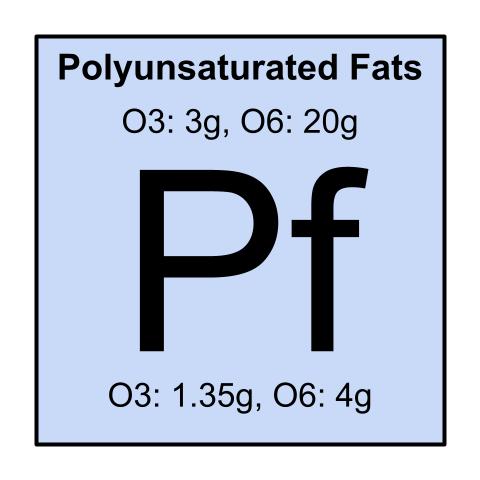Polyunsaturated fats are hydrocarbons with two or more double bonds in their carbon chain. They include omega-3s and omega-6s. Our ancestors ate these in a ratio of 1:1, whereas modern diets contain about 15:1, which promotes many diseases including cardiovascular disease, cancer, and inflammatory and autoimmune diseases. Both are highly essential for the brain, growth and development, metabolism, reproduction, and energy. Vegetable oils are poor sources of omega-6s, whereas healthy sources may include animal products, and nuts. Sources of omega-3s include fish and grass fed meats.
Toxicity
-Depends on the type of polyunsaturated fat, see below.
-Note: we historically had a ratio of omega-6 to omega-3 of 1:1 gram for gram. Typical Western diets are about 15:1, which promotes the pathogenesis of many diseases including cardiovascular disease, cancer, and inflammatory and autoimmune diseases [123].
Omega 3 Fatty Acids
-A fatty acid with a double bond 3 carbons away from the end of the chain, but also has other double bonds
-Essential to get from diet, can’t be made in the body
-There are many types, most common are: EPA, DHA, and ALA
-Eicosapentaenoic acid (EPA): allows the creation of molecules that help reduce inflammation, and symptoms of depression
-Docosahexaenoic (DHA) is very important for brain function and development, and can be up to 8% of our brain weight. It is in high amounts in retina and sperm cells as well
-Alpha-linolenic acid (ALA) can be used for energy, and to make DHA and ALA, but it seems to convert to an equivalent of <1% – 8% DHA, and <1 – 20% EPA, so it is inefficient
[28][29]
-Strongly linked to mental health and cognitive performance [30]
-Serve important functions in blood vessels, heart, immune system, lungs, and endocrine system [31]
RDI
-Combined EPA and DHA (minimum): 250mg to 500mg
-ALA (minimum): 1.6g for men, 1.1g for women.
-Total (minimum) = 1.35 g
[122]
Deficiency
-Symptoms are varied: depression, inflammation and arthritis, weight gain, difficulty learning, unhealthy skin, memory loss, weakened immune system, fatigue, and eyesight problems [124]
Toxicity
-Too much omega 3 may cause blood to be too thin, but consuming too much of omega-3 is rare
Sources
Animal Sources
(EPA and DHA)
Mackerel, salmon, herring, oyster, sardines
Plant sources
(ALA)
Anchovies, caviar, flax seeds, chia seeds, walnuts, soybeans
Oils and Fats
Cod liver oil, other omega-3 fish oils [144]
Omega 6 Fatty Acids
-A fatty acid with a double bond 6 carbons away from the end of the chain, but also has other double bonds
-Essential to get from diet, can’t be made in the body
-Supports brain function, normal growth and development, hair and nail growth, immune function, reproductive function, regulates metabolism, produces energy, and helps maintain bone health
-Some omega-6 fatty acids promote inflammation, and many doctors recommend a ratio of not more than 3:1 grams of omega-6 to omega-3
[32]
-Makes pro-inflammatory molecules that help the immune system [148]
RDI
17 grams [145]
Deficiency
-Rare [148]
-Symptoms include dry, flakey skin, thick patches on skin, cracked skin, frequent nose bleeds, brittle nails, dry eyes, dry hair, dandruff or hair loss, itchy skin, eczema or other skin conditions [148]
Toxicity
-Excess omega-6 promotes the pathogenesis of many diseases including cardiovascular disease, cancer, and inflammatory and autoimmune diseases [123]
Sources
Animal Sources
Chicken thigh, turkey
Plant sources
Tofu, walnuts, peanut butter
Oils and Fats
Vegetable oils like canola oil, corn oil, soybean oil, safflower oil and foods fried in vegetable oils like onion rings, french fries etc, pre-made salad dressings with vegetable oils, margarine, shortening, chicken fat. [143][145]

